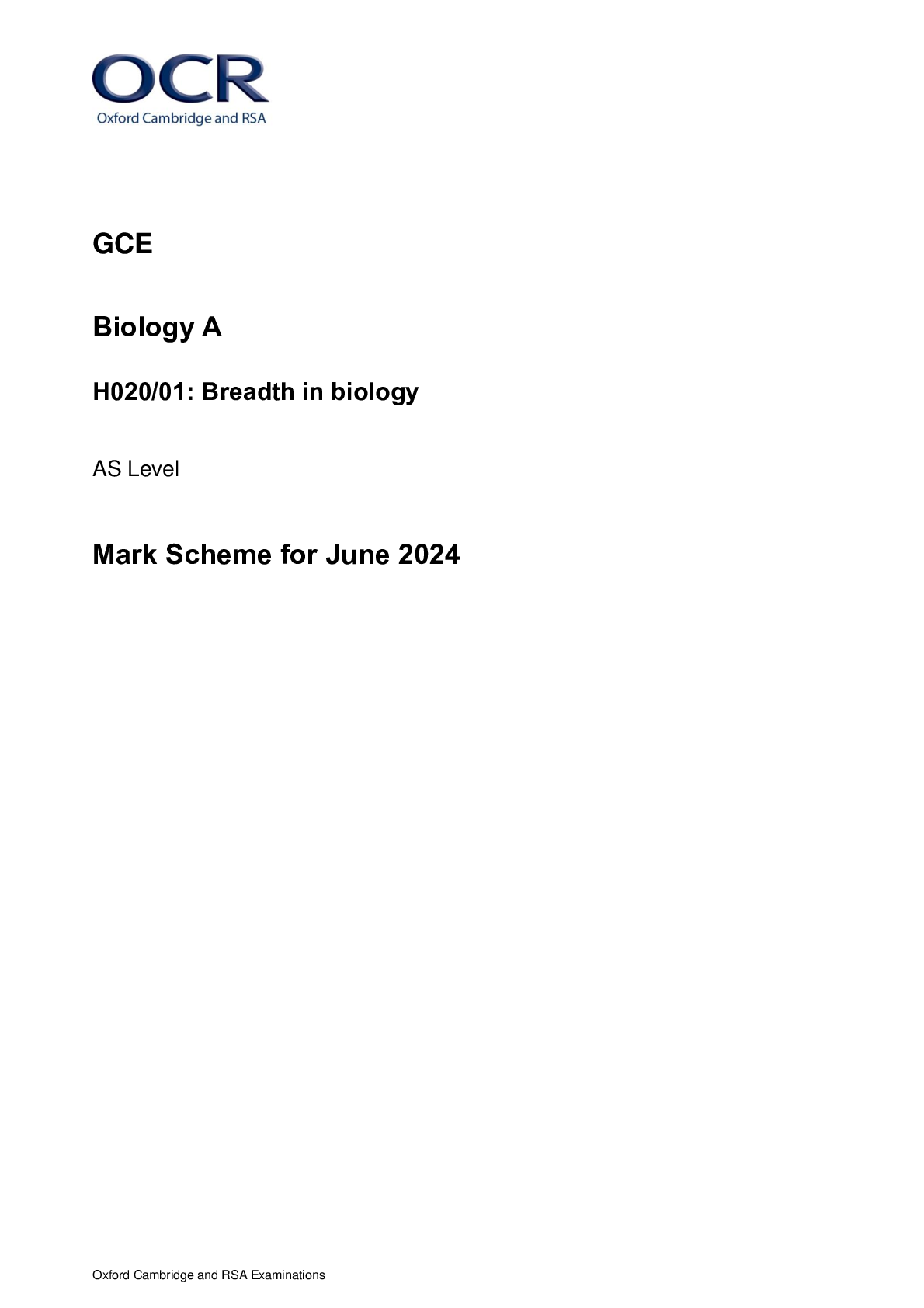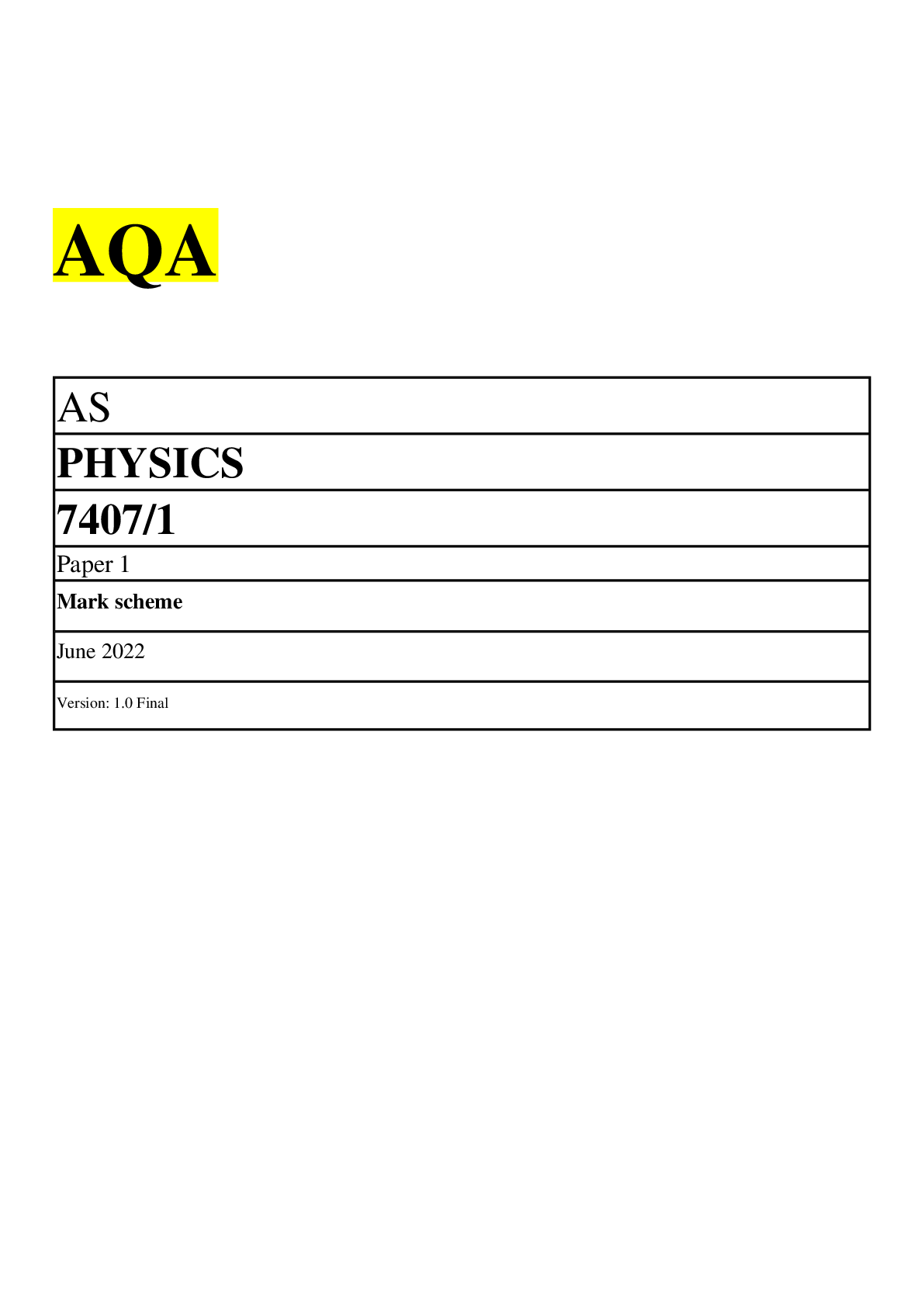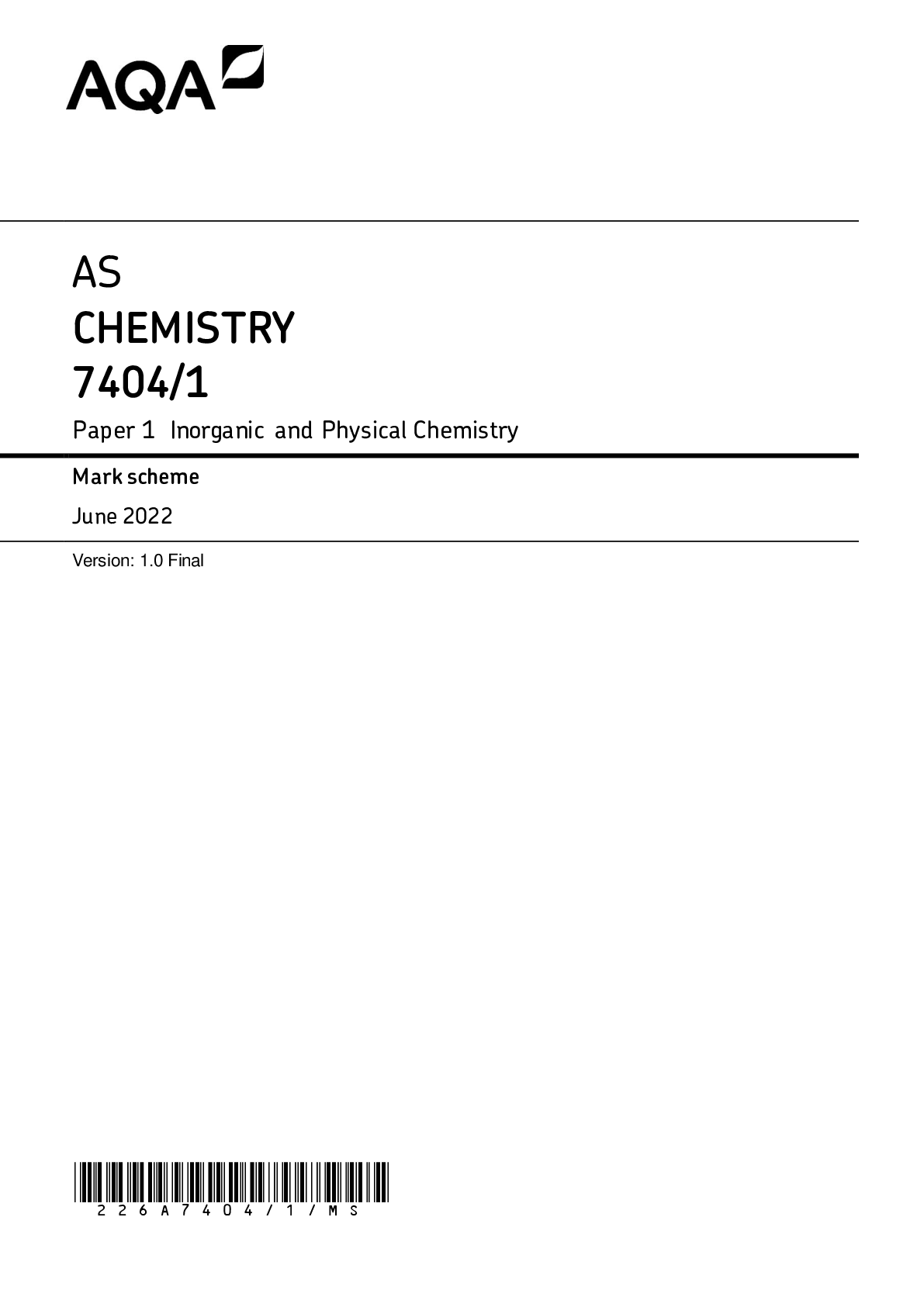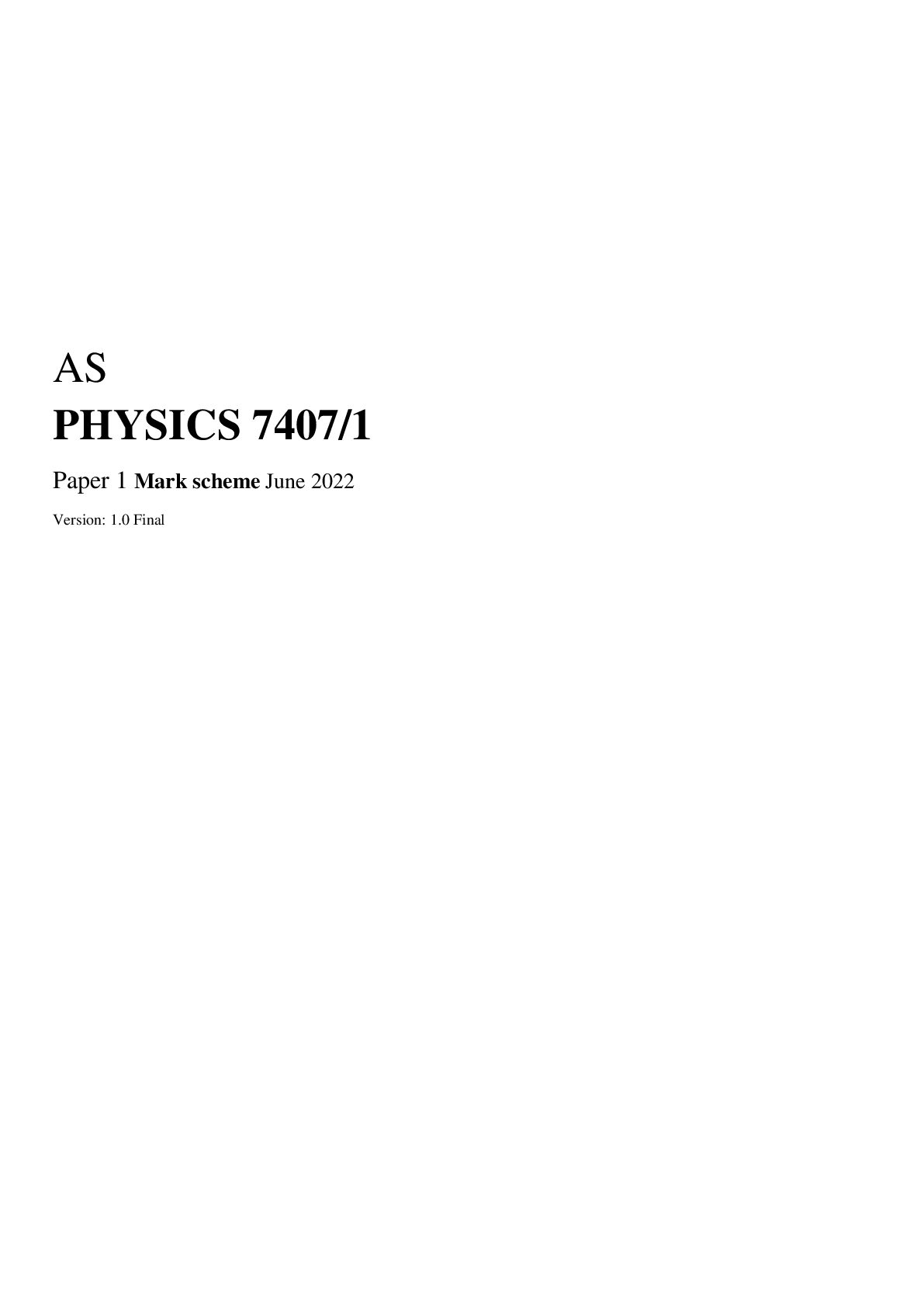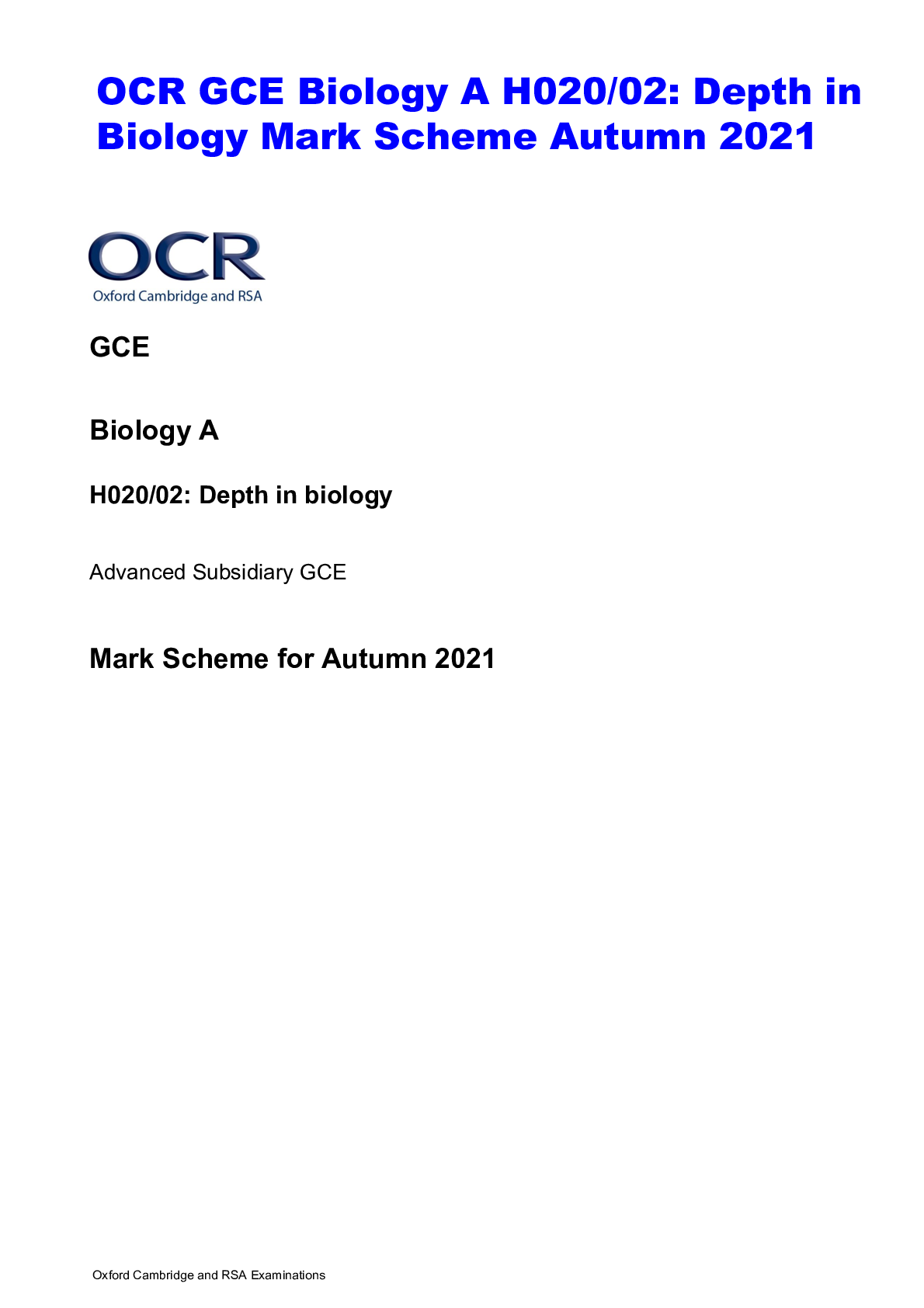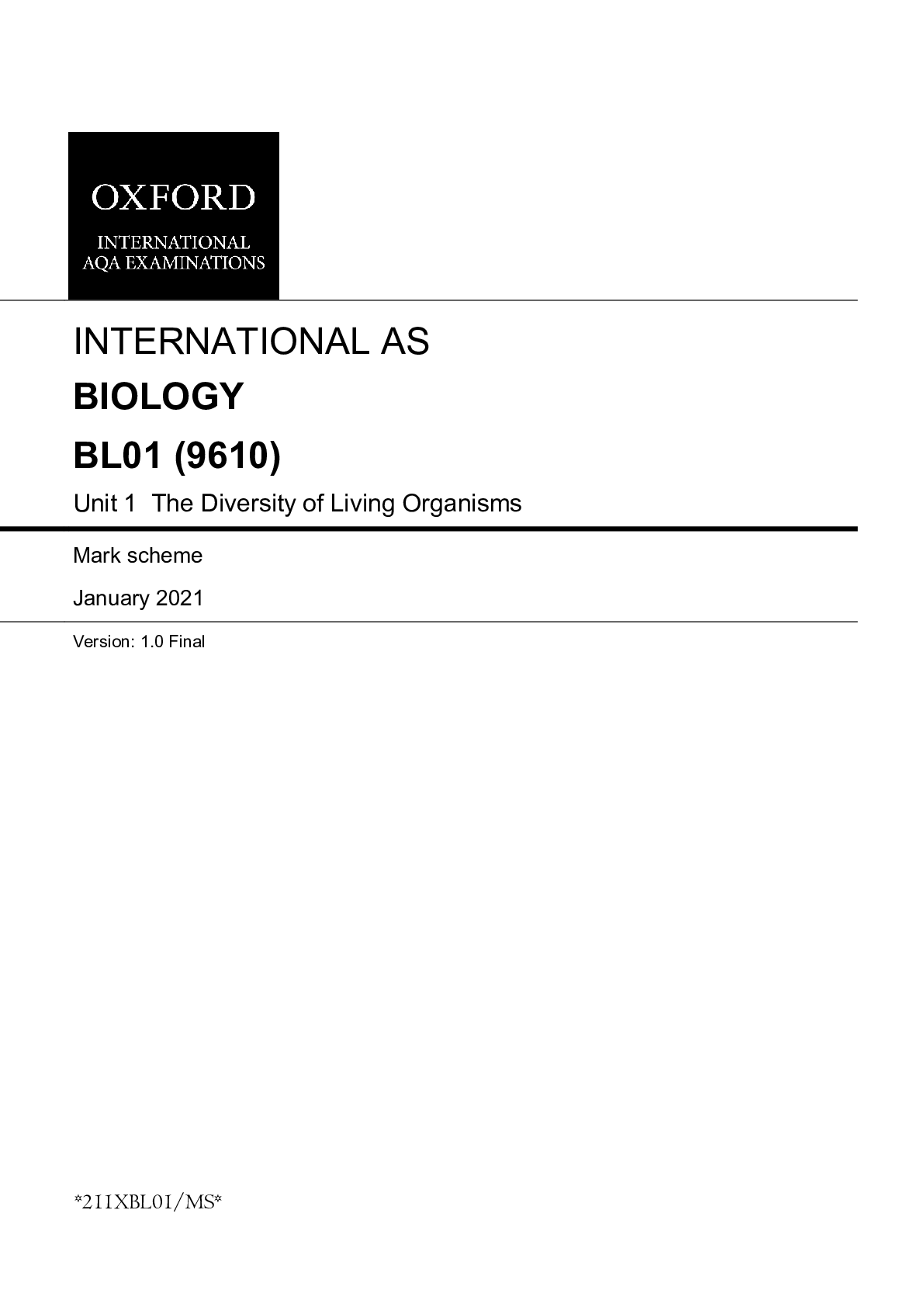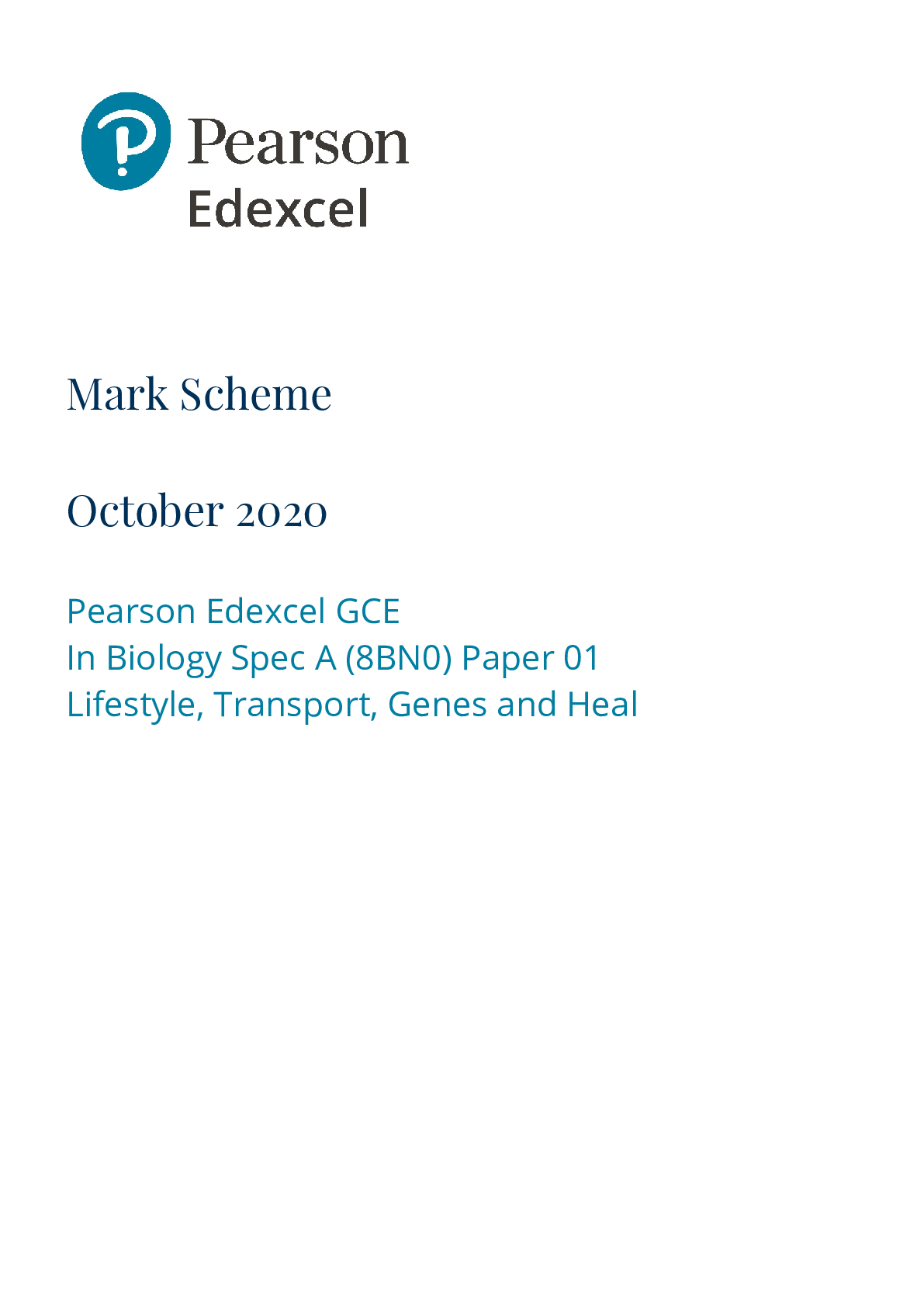English Language > AS Mark Scheme > GCE English Language H470/01: Exploring language Advanced GCE Mark Scheme for November 2020 (All)
GCE English Language H470/01: Exploring language Advanced GCE Mark Scheme for November 2020
Document Content and Description Below
Oxford Cambridge and RSA Examinations GCE English Language H470/01: Exploring language Advanced GCE Mark Scheme for November 2020Oxford Cambridge and RSA Examinations OCR (Oxford Cambridge and R ... SA) is a leading UK awarding body, providing a wide range of qualifications to meet the needs of candidates of all ages and abilities. OCR qualifications include AS/A Levels, Diplomas, GCSEs, Cambridge Nationals, Cambridge Technicals, Functional Skills, Key Skills, Entry Level qualifications, NVQs and vocational qualifications in areas such as IT, business, languages, teaching/training, administration and secretarial skills. It is also responsible for developing new specifications to meet national requirements and the needs of students and teachers. OCR is a not-for-profit organisation; any surplus made is invested back into the establishment to help towards the development of qualifications and support, which keep pace with the changing needs of today’s society. This mark scheme is published as an aid to teachers and students, to indicate the requirements of the examination. It shows the basis on which marks were awarded by examiners. It does not indicate the details of the discussions which took place at an examiners’ meeting before marking commenced. All examiners are instructed that alternative correct answers and unexpected approaches in candidates’ scripts must be given marks that fairly reflect the relevant knowledge and skills demonstrated. Mark schemes should be read in conjunction with the published question papers and the report on the examination. © OCR 2020H470/01 Mark Scheme November 2020 2 Annotations Annotation Meaning Blank Page – this annotation must be used on all blank pages within an answer booklet (structured or unstructured) and on each page of an additional object where there is no candidate response. Positive Recognition Assessment Objective 1 Assessment Objective 2 Assessment Objective 3 Assessment Objective 4 Assessment Objective 5 Attempted or insecure Analysis Detailed Link Vague IrrelevantH470/01 Mark Scheme November 2020 3 INTRODUCTION Your first task as an Examiner is to become thoroughly familiar with the material on which the examination depends. This material includes: • the specification, especially the assessment objectives • the question paper and its rubrics • the texts which candidates have studied • the mark scheme. You should ensure that you have copies of these materials. You should ensure also that you are familiar with the administrative procedures related to the marking process. These are set out in the OCR booklet Instruction for Examiners. Please ask for help or guidance whenever you need it. Your first point of contact is your Team Leader.H470/01 Mark Scheme November 2020 4 These are the Assessment Objectives for the English Language specification as a whole. AO1 Apply appropriate methods of language analysis, using associated terminology and coherent written expression. AO2 Demonstrate critical understanding of concepts and issues relevant to language use. AO3 Analyse and evaluate how contextual factors and language features are associated with the construction of meaning. AO4 Explore connections across texts, informed by linguistic concepts and methods. AO5 Demonstrate expertise and creativity in the use of English to communicate in different ways. WEIGHTING OF ASSESSMENT OBJECTIVES The relationship between the units and assessment objectives of the scheme of assessment is shown in the following table: Component % of A level AO1 AO2 AO3 AO4 AO5 Total Exploring language H470/01 11% 6% 11% 6% 6% 40% Dimensions of linguistic variation H470/02 11% 11% 12% 6% 0% 40% Independent language research H470/03 5% 5% 5% 0% 5% 20% 27% 22% 28% 12% 11% 100%H470/01 Mark Scheme November 2020 5 USING THE MARK SCHEME Study this Mark Scheme carefully. The Mark Scheme is an integral part of the process that begins with the setting of the question paper and ends with the awarding of grades. Question Papers and Mark Schemes are developed in association with each other so that issues of differentiation and positive achievement can be addressed from the very start. This Mark Scheme is a working document; it is not exhaustive; it does not provide ‘correct’ answers. The Mark Scheme can only provide ‘best guesses’ about how the question will work out, and it is subject to revision after we have looked at a wide range of scripts. The Examiners’ Standardisation Meeting will ensure that the Mark Scheme covers the range of candidates’ responses to the questions, and that all Examiners understand and apply the Mark Scheme in the same way. The Mark Scheme will be discussed and amended at the meeting, and administrative procedures will be confirmed. Co-ordination scripts will be issued at the meeting to exemplify aspects of candidates’ responses and achievements; the coordination scripts then become part of this Mark Scheme. Before the Standardisation Meeting, you should read and mark in pencil a number of scripts, in order to gain an impression of the range of responses and achievement that may be expected. In your marking, you will encounter valid responses which are not covered by the Mark Scheme: these responses must be credited. You will encounter answers which fall outside the ‘target range’ of levels for the paper which you are marking. Please mark these answers according to the marking criteria. Please read carefully all the scripts in your allocation and make every effort to look positively for achievement throughout the ability range. Always be prepared to use the full range of marks.H470/01 Mark Scheme November 2020 6 PAPER-SPECIFIC INSTRUCTIONS: H470/01 Exploring language Candidates answer all the questions on the paper. The paper addresses all of the assessment objectives: Assessment Objectives AO1 and AO3 are addressed in question 1. Assessment Objectives AO2 and AO5 are addressed in question 2. Assessment Objectives AO1, AO3 and AO4 are addressed in question 3. In each question, the assessment objectives are given equal weighting. THE INDICATIVE CONTENT FOR EACH TASK provides an indication of what candidates are likely to cover. The notes are neither prescriptive nor exhaustive: candidates should be rewarded for any relevant response which appropriately addresses the Assessment Objectives. THE LEVEL DESCRIPTORS FOR EACH QUESTION FOLLOW THE INDICATIVE CONTENT. SUBJECT-SPECIFIC INSTRUCTIONS: ENGLISH LANGUAGE • Each level descriptor covers the relevant assessment objectives. • Where the assessment objectives appear in separate columns, marks should be allocated for each assessment objective independently of one another. • There is no requirement for responses to be allocated marks from within the same level across each assessment objective. • An answer does not have to meet all the requirements of a level descriptor before being placed in that level. The extent to which it meets all of the requirements of a level descriptor will determine its placement within that level. • The extent to which the statements within the level have been achieved should be the only criteria used when deciding the mark within a level. • Indicative content indicates possible points candidates might make, but this is not an exhaustive account. Any valid response should be rewarded.H470/01 Mark Scheme November 2020 7 Indicative Content – Please note: indicative content indicates possible points candidates might make, but this is not an exhaustive account. Any valid response should be rewarded. Question Guidance Marks Text features 1 Text A is an extract from a LinkedIn e-Book advising interviewers on what questions to ask candidates who have applied for a position within their company. LinkedIn is a social media platform specifically designed for business professionals. Giving careful consideration to the context of the text: (a) identify and analyse patterns of lexical and semantic use (b) identify and analyse the way sentences are constructed. Possibilities are provided below for guidance but any valid response should be rewarded. General contextual points (AO3): Candidates can bring their knowledge of social media generally to this text with consideration of the fact that due to the target audience of business professionals, it is expected that more Standard English would be used compared to Facebook, Twitter and Instagram. The genre of an eBook indicates the planned nature of the text and the purpose of advising should bring forth answers surrounding power strategies. It is worth noting that students will not gain marks for including concepts/theories in this question but can make contextual references to relevant issues such as power. 20 In each of the bullet points below, AO1 is covered at the start of the point and AO3 at the end. (a) identify and analyse patterns of lexical and semantic use. Possible features could be: • use of clinical lexis such as ‘screening’ creates a professional, yet depersonalised register; there are also markers of a scientific register with the name of the LinkedIn department (‘Talent Solutions’) • pre-modification of (‘soft skills’) is very loaded; contextually, this is an area that elicits different opinions from employers although the influence of LinkedIn might sway employers to value these qualities positively • use of superlative (‘toughest’) creates contrast with the connotations of adjective (‘soft’) • second person pronoun (‘you’) is used by producer to situate the receiver contextually in the interview room making them an active agent in the process • collocation is present (‘The good news is..’) to reassure receiver positively and tie in with the goal of offering ‘solutions’ • American English spellings (‘prioritize’) are indicators of platform’s origins and recognisable as global variety of English required for global communicationsH470/01 Mark Scheme November 2020 8 Although the majority of candidates will not have been involved in recruitment, a proportion of them will be able to relate to the interview process if they have a parttime job. They are able to draw upon these experiences considering the need for interviewers to avoid being too face-threatening towards applicants in the process of recruitment. They should also consider the growth of the e-Book genre and given the nature of the platform being online, it is expected that they would continue to use online modes to appeal to its client base. • Abstract nouns are present in a list of soft skills (e.g. ‘Leadership’) which are not easily measurable but cliched job requirements (b) identify and analyse the way sentences are constructed. Possible features could be: • use of complex sentences with non-finite subordinate clauses (‘To find out what…’) to direct the receiver to required information with main clause justifying the evidence for their recommendations • verb phrases (e.g. ‘walk you through’) suggest ease of content dissemination • initial position/fronted conjunctions are used to begin sentences as coordinate clauses (‘And it makes sense…’) to fluidly move from one section of the discourse to another • use of softened imperatives (‘Tell me about a time when…’) and interrogatives (‘How did you react?’) to emulate the interview process offering exemplar scaffolding for the interviewer • use of declaratives provide assurances to the receiver accompanied with definite article and convincing adjective (‘The 6 essential soft skills to screen for’) • non-standard use of direct speech (‘69% of hiring managers say adaptability is the most important…’) using present tense without speech marks rather than reported speech in past tenseH470/01 Mark Scheme November 2020 9 There are a total of 20 marks available for Question 1. 10 marks can be awarded for part (a) and 10 marks for part (b). There is one mark per level for each AO. This table should be used twice – firstly to mark part (a) and allocate a mark out of 10, and then again to mark part (b) and allocate a mark out of 10. Parts (a) and (b) focus on different language levels, and therefore each part could achieve different language levels. Each part should be marked completely separately – there is no need to look for consistency in allocating marks if the responses demonstrate different levels of competency. Level AO1 and AO3 Mark 5 • Candidates clearly identify patterns of language use in precise relation to the linguistic level specified in the task and can closely analyse incisively chosen evidence, with application of appropriate terminology; the writing is in a secure academic register. (AO1) • With a precise hold on the language feature specified in the task, candidates perceptively evaluate the possible effect of contextual factors on the way language is produced in this text and is received and understood by its audience. (AO3) 9–10 4 • Candidates can single out and analyse relevant examples of language use related to the linguistic level specified in the task, with application of appropriate terminology and coherent written expression. (AO1) • Focusing on the language feature specified in the task, candidates can convincingly weigh up some possible effects of contextual factors on the way language is produced in this text and the way it is received and understood by its audience. (AO3) 7–8 3 • Candidates make some clear points about language use which relate to the specified language level and are supported with relevant evidence; use of terminology is mostly appropriate, although likely to be less densely packed than the level above and written expression is clear but likely not to be economical. (AO1) • Having a reasonable sense of the language feature specified, candidates come to some clear conclusions about the possible effect of contextual factors on the way language is produced in this text and is received by its audience. (AO3) 5–6 2 • Candidates attempt to make their writing relevant to the feature and language level specified in the task, pulling out the occasional piece of evidence and using terminology which is partially appropriate; written expression has some errors but the meaning is nonetheless apparent. (AO1) • Having some sense of the language feature specified, candidates come to some fairly loose conclusions about the possible effect of contextual factors on the way language is produced in this text and is received by its audience. (AO3) 3–4 1 • Candidates make some link to the specified feature and language level and some terms are used appropriately; evidence, if any, is likely to be barely relevant or only loosely defined (not actually quoted, for example) and writing may at times obscure meaning. (AO1) 1–2H470/01 Mark Scheme November 2020 10 • Conclusions about the possible effect of contextual factors on the way language is produced and is received by the audience will be somewhat indistinct. There may be a vague sense of the text’s purpose. (AO3) 0 • No response or no response worthy of any credit. 0H470/01 Mark Scheme November 2020 11 Indicative Content – Please note: indicative content indicates possible points candidates might make, but this is not an exhaustive account. Any valid response should be rewarded. Question Guidance Marks Text features 2 ‘We need to self-censor our public discourse in order to protect people.’ Write a broadsheet newspaper article critically responding to this statement. ‘Public discourse’ can refer to any written or spoken communication which is widely available to the general public. Valid areas for discussion might be the media, news, political arenas, social media or public debates. You need to engage a reasonably well-educated, non-specialist audience. It should be no more than 500 words. AO5 Candidates should aim for a relatively high register given the form as a broadsheet newspaper article; however, certain informal/spoken elements of language can be used in order to create an individual, journalistic voice within the response. Candidates would be advised to begin their response with a title which is not the topical language issue statement. Reframing the statement as the title with a specific context/case study as the focus of the response will lead to more insightful answers. Candidates should be aware of not being overly generic with their responses. They should consider what they have recently read in broadsheet articles regarding topics such as political correctness and the fact that journalists have a specific story to tell, usually with a case study. 24 AO2 Whilst candidates are likely to provide arguments in favour of the statement, to simply only agree with it will limit marks for this AO due to not engaging critically (as per the question) with the concept of self-censorship and its effects on language. In order to sufficiently demonstrate knowledge and understanding for this topical language issue, candidates must show an understanding of selfcensorship, bringing to bear their knowledge of language change concepts such as political correctness. Candidates should consider both written and spoken forms of public discourse and there is scope to develop their arguments with a focus on language use in social media and the concept of online identity.H470/01 Mark Scheme November 2020 12 There is no need for candidates to spend time formatting the discourse into columns; no extra marks will be awarded for this. Marks will be awarded for the register used and the ability to create a preciselystructured piece with concluding comments from the journalist on their view of the statement. Below are some areas that could be covered: • Political correctness – an awareness of how this movement began c.1970s and has continued in light of liberation of protected characteristics such as gender, gender identity, race, sexual orientation, disability, religion, etc. Students may comment on simplified, tabloid responses to this concept with notions that PC has ‘gone too far’ • Linguistic determinism/relativity – students can bring in knowledge on the Sapir-Whorf hypothesis to bear on this statement evaluating how hegemonic discourse influences people’s thoughts • Censorship vs. freedom of speech argument – central to this statement is the debate between these two concepts and the boundaries between having freedom of speech and offending somebody without intention • Reclamation of language – students can also develop arguments regarding the controversial issue of different minority groups reclaiming words that were used previously against them and how it is only acceptable for certain speech communities • Influence of social media – students can bring in relevant contextual information/case studies on the influence of platforms in terms of selfrepresentation and the construct of online identities • Private vs. public discourse – are the boundaries between these two concepts blurring? • TV censorship – students can bring in concepts like the ‘Watershed’ and the impact of taboo language on young peopleH470/01 Mark Scheme November 2020 13 There are a total of 24 marks available for Question 2. Decide on a mark for AO2 out of 12, and then a separate mark for AO5 out of 12. Add the two marks together to reach a total out of 24 marks. It is possible that candidates may achieve different levels for each AO: allocate the mark according to the level of competency demonstrated for each AO individually. Level AO2 Mark AO5 Mark 6 • In their piece of writing, candidates show an assured knowledge and understanding of the specified concept and issue and its relevance to language use. • Candidates engage critically with the specified concept and issue. 11–12 • An expertly-constructed text showing, perhaps surprising, originality in making the piece appropriate to the form specified in the task. • The use of appropriately chosen linguistic features shows flair and the writing precisely suits the audience defined in the task. 11–12 5 • In their piece of writing, candidates show a good knowledge and understanding of the specified concept and issue and its relevance to language use. • In their piece, candidates show that they can take a critical angle on the specified concept and issue. 9–10 • A well-constructed text, which is appropriate to the form specified in the task. • The use of appropriately chosen linguistic features shows skill and their writing suits the audience defined in the task. 9–10 4 • In their piece of writing, candidates show an essentially sound level of knowledge and understanding of the specified concept and issue and its relevance to language use. • Candidates show that they have some ability to think and write critically about the concept/issue. 7–8 • A deliberately constructed text, which contains most of the main elements of the form specified in the task. • There is clear use of appropriate linguistic features and the writing has been modulated to take account of the audience defined in the task. 7–8 3 • Their knowledge and understanding of the chosen language concept or issue is mostly accurate, although is likely to lack the depth needed to be convincing. • In their piece of writing, candidates have addressed the specified concept/issue, although not critically. 5–6 • A text which is attempting to match the task’s purpose and which is at least recognisable as an example of the form specified in the task. • There are some appropriate language features employed and some attempts have been made to take account of the audience defined in the task. 5–6 2 • Candidates’ knowledge and understanding of the concept/issue is likely to have inaccuracies or be muddled. • The language concept/issue is present in the piece although somewhat indistinct or confused. 3–4 • A text which has some sense of the form specified in the task, but which leaves out key elements. • There are some attempts to use appropriate language features, although probably not employing a register which suits the audience defined in the task. 3–4H470/01 Mark Scheme November 2020 14 Level AO2 Mark AO5 Mark 1 • Candidates do not appear to understand the concept or issue but it is possible to see one or two points relating to it. • The language concept or issue will be just barely detectable in the piece. 1–2 • Candidates produce writing which has little sense of the specified task, although there may be one or two superficial features of the form specified in the task. • One or two appropriate language features may be present; the audience is not understood or addressed. 1–2 0 • No response or no response worthy of any credit. 0 • No response or no response worthy of any credit. 0H470/01 Mark Scheme November 2020 15 Indicative Content – Please note: indicative content indicates possible points candidates might make, but this is not an exhaustive account. Any valid response should be rewarded. Question Guidance Mark Text features 3 Using appropriate linguistic concepts and methods, analyse the ways in which language is used in these two texts. In your answer you should: • explore connections and variations between the texts • consider how contextual factors contribute to the construction of meaning. AO3 Both texts share the same subject matter of teens’ use of language on social media although Text B, a transcript from the Radio 4 programme, Word of Mouth, explores the 36 Phonetics, phonology and prosodics Text B Text C • Shouting used ‘(GOOD MOOORNING’) to realise his orthographical variation used to present enthusiastic welcome message to followers • Glottal stops are used by Cairney with use of ‘Twi’er’ to indicate non-standard forms of English (London variety) • ‘h/g’ dropping is also present from Grimshaw which he explicitly references as a northern accent feature within the transcripts; many students will be aware of his strong accent which he promotes • Standard English is used throughout with no attempt at phonetic spellings.H470/01 Mark Scheme November 2020 16 different identities that young people present in person compared with online. Text C, an extract from a Guardian article on the perceptions of teens’ obsession with social media, focuses more specifically on their online identities. Audiences of the two texts will differ. Typically, Word of Mouth is listened to by an older, middle class audience but, in this context, the subject matter might be less relatable. Guardian online articles are typically read by young progressives although of an older age than the teens in discussion. Candidates will no doubt be aware of the context surrounding this subject matter often critiqued in the press from spending too much time unconstructively on social media and lacking the face-to-face social skills of older generations. The mode of both texts differ with Text B, primarily written with spoken elements (mixed mode) and of a lower formality to Text C which is multimodal. Purposes of both texts are to inform primarily, although, arguably, Text B is also to entertain. Lexis and semantics Text B Text C • Use of fillers ‘erm’ and ‘like’ by Grimshaw which are typical elements of his spoken discourse, notably more unplanned compared to Cairney framing discourse • Generally high frequency lexis used throughout by both interlocutors; used specifically for effect by Grimshaw such as (‘bad girl’) when describing Rihanna’s hashtag use and humour provided when comparing to a relative who lives in an affluent area with the cultural reference of ‘Hampstead’ • Lexical field of technology and social media with names of platforms (Twitter, Instagram) including semantic changes to terms such as ‘tweeted’ and ‘hashtag’ • Individual voice of journalist is realised through first person singular pronouns ‘I don’t think so’ to indicate opinion/authority to influence • Humour integrated through use of premodified noun phrases (‘emoticon-addled zombies’) purposefully creating distance between receivers and teenagers • Explicit reference to receivers of text with second person pronouns consciously conveying bias (‘cherry-picked to startle you’) • Use of neologisms (‘refusenik’) with the suffix ‘nik’ commonly applied to describe people with a particular quality • Spoken sociolect of teenagers with conversion of word class from noun to adjective (“I’m all Instagram”)H470/01 Mark Scheme November 2020 17 AO4 Candidates should apply their knowledge of conversation analysis to Text B with a focus on Cairney’s role as host of the programme and how she structures the discourse with her friend and colleague, Nick Grimshaw. Students can bring in relevant power concepts, especially given Grimshaw’s personal power as a wellknown Radio 1 presenter which also gives him influential power especially on social media through his followers. Candidates can also apply their knowledge of spoken varieties with both interlocutors using nonstandard forms throughout. Power concepts can also be applied to Text C focusing on the representation of teenagers (social group power) and the bias from the news source. Equally, concepts surrounding the discourse structure of both texts would be a useful comparison point with adjacency pairs of question/answer and spoken voice of journalist materialising in Text C. Grammar and morphology Text B Text C • Cairney uses a mixture of explicit interrogatives (‘…how they do in real life?’) and imperatives with pragmatic implications (‘let’s read some of your tweets’) to elicit answers from Grimshaw • Non-standard use of syntax from both participants: Cairney uses non-standard relative pronouns (‘people that talk differently’) and Grimshaw switches from using third person to second person pronoun (‘they’re from Hampstead…I don’t know why you’re talking…’) • Syntactic mirroring between the two interlocutors illustrating close cooperation given the nature of the show and their social position as presenters (C: ‘let’s read some of your tweets (G: ‘okay let’s see...) • Reformulated syntax (‘let’s see what I’ve erm let’s see what I’ve tweeted) presumably due to locating material • Interrogative followed by declarative (rogatio) used as a rhetorical scheme within the standfirst (‘Is too much socialising…Not according to…’) to dispel common myths about young people and social media usage • Use of minor exclamatives (‘Shocking!’) to convey personal opinion of journalist in relation to extreme case study • Quaestitio and anaphora used to provide convincing possible rationale through embedded clauses (‘unable to connect, unable to think’) • Use of imperatives to guide the audience through the producer’s argument (‘Let’s go back to that girl…’) • Non-standard syntax with fronted conjunctions to begin sentences (‘And…’) to mimic pseudo-spontaneous discussion with receiver Pragmatics Text B Text C • Grimshaw uses the adjective ‘guilty’ to imply that speaking differently online compared to face-to-face is not fully socially acceptable • Humour conveyed through referencing popstar to a ‘bad girl’; connotations of this noun phrase are left open to the receiver • Incongruity achieved through implying ‘Hampstead’ is not an area where ‘talk[ing] street’ is appropriate through negative constructions (‘don’t know why’) • Title of article exploits implied understanding of negative associations between teenagers and social media tentatively using mitigation (‘might actually’) to provide a challenge to the dominant narrative • Humour achieved through contrast of using a simple social media app and international conflict through simile (‘like a cold war communique’)H470/01 Mark Scheme November 2020 18 Discourse Text B Text C • Cairney’s role in the text is the agenda setter and she frames the discourse with pre-scripted questions. Eliciting information is used through cooperative imperatives (‘let’s read some of your tweets’) • Use of coordinating conjunction (‘and’) by Cairney and informal discourse markers (okay, so) continues the discourse in a more fluid structure to avoid stilted Q&A pattern • Backchannelling used by Grimshaw as a form of cooperative speech (//oh yeah//) and many instances of latching in which suggests a close understanding of each others’ transition relevance places • Q&A structure to begin position of argument by the journalist in standfirst • Multimodal discourse structure with graphic of individual female teenager immersed in content on her phone with a positive caption beneath (‘tend to spend more time socialising in the real world’) • Producer uses build-up, knock down introduction providing a list of individuals with personal power who have advocated the negatives attached to social media with hyperbolic quaestitio leading the receiver to discredit their arguments • Conversational snapshots are provided of ‘real life’ teenage discourse to present personalisationH470/01 Mark Scheme November 2020 19 There are a total of 36 marks available for Question 3. Decide on a mark for AO1 out of 12, and then a separate mark for AO3 out of 12, and a separate mark for AO4 out of 12. Add the three marks together to reach a total out of 36 marks. It is possible that candidates may achieve different levels for each AO: allocate the mark according to the level of competency demonstrated for each AO individually. Level AO1 Mark AO3 Mark AO4 Mark 6 • Candidates apply a range of appropriate methods in an assured and systematic way, using appropriate terminology and writing in a secure academic register. • They deftly establish and explore patterns of language use and can closely analyse incisively chosen evidence. 11–12 • Candidates make discerning points about the possible effect of contextual factors on particular features of language, both in terms of production and reception. • They perceptively evaluate their points, suggesting alternatives for how context might account for variations in language use. 11–12 • Candidates selectively and methodically apply confident knowledge of appropriate linguistic concepts across both texts. • Candidates compare particular linguistic features in the two texts, making illuminating connections between them which clearly establish some of the varied ways that language is used. 11–12 5 • Candidates apply a range of appropriate methods to the texts in a systematic way, using appropriate terminology and coherent written expression. • They establish patterns of language use and can analyse well-chosen evidence in some depth. 9–10 • Candidates make strong and helpful points about relevant contextual factors, showing how context might affect language use, both in terms of production and reception. • They show that they can weigh up how contextual factors might account for variations in language use. 9–10 • Candidates methodically apply sound knowledge of appropriate linguistic concepts across both texts. • Candidates compare linguistic features in the two texts, making helpful connections between them which show some of the ways that language varies. 9–10H470/01 Mark Scheme November 2020 20 Level AO1 Mark AO3 Mark AO4 Mark 4 • Candidates apply some appropriate methods in a sound way, using mostly appropriate terminology and coherent if uneconomical writing. • Analysis is characterised by either a fairly limited number of well-developed points, with relevant evidence, or a larger number of valid supported points that lack depth. 7–8 • Candidates make some valid points about context, showing how contextual factors can affect language production and reception. • They come to some sound conclusions about how contextual factors could cause variations in language. 7–8 • Candidates apply accurate knowledge of linguistic concepts to language features in a way that is mostly appropriate, across both texts. • They make some comparisons of linguistic features in the two texts, making some connections between them which show ways in which language use varies. 7–8 3 • Candidates attempt to apply linguistic methods with some success, and terminology is at times appropriate; written expression contains some errors. • Analysis is uneven and is characterised by either scattered points that are supported with evidence or points which may have validity but are unsupported. 5–6 • Candidates make a few successful attempts at showing how basic contextual factors affect the way language is produced and received. • Conclusions drawn tend to be assertive and simplistic rather than weighed in the balance and are sometimes unconvincing; there may be an elementary sense of how context affects language variation. 5–6 • Candidates have a loose grasp of linguistic concepts and attempt to apply them to both texts, although sometimes unconvincingly. • They will make more general connections and will attempt to compare particular features but with only partial success. 5–6H470/01 Mark Scheme November 2020 21 Level AO1 Mark AO3 Mark AO4 Mark 2 • Candidates make a vague attempt to apply linguistic methods to the texts and some terms are used, with occasional appropriateness; writing is likely to contain errors which sometimes obscures meaning. • One or two simple points are made, with little or tenuous evidence; assertive rather than analytical. 3–4 • Candidates can comment on context, although this is unlikely to show proper grasp of production and reception and so is of very limited use. • Evaluation of points is not happening in this level because there is no real exploration of language, but there may be one or two generalisations made about the effects of context on the language. 3–4 • Where linguistic concepts are in evidence for each text, understanding is shallow and knowledge of them is likely to be muddled. • Some loose connections between the texts are established in one or two places in the answer. These connections are likely to be simple matching and contrasting of features with very little demonstration of how language varies. 3–4 1 • Candidates struggle to apply the linguistic methods; terminology, if present, is inappropriate and accuracy of written expression is very limited. • There may be the odd point made but there is no analysis with evidence. 1–2 • One or at the most two references are made to the context with no link to language production or reception. • Little or no attempt to draw conclusions about the effect of context on different uses of language. 1–2 • Any knowledge of linguistic concepts is likely to be mostly inaccurate with perhaps a very vague sense of understanding both texts being present. • The notion of comparison is essentially lost in this level. There may be one or two connections here and there but these do not help with notions of the varieties of language use. 1–2 0 • No response or no response worthy of any credit. 0 • No response or no response worthy of any credit. 0 • No response or no response worthy of any credit. 0H470/01 Mark Scheme November 2020 22 APPENDIX 1 Assessment Objective weightings are given as percentages. Assessment Objectives Grid Question AO1% AO2% AO3% AO4% AO5% Total% 1 5 0 5 0 0 10 2 0 6 0 0 6 12 3 6 0 6 6 0 18 Totals 11% 6% 11% 6% 6% 40%OCR (Oxford Cambridge and RSA Examinations) The Triangle Building Shaftesbury Road Cambridge CB2 8EA [Show More]
Last updated: 3 years ago
Preview 1 out of 24 pages

Buy this document to get the full access instantly
Instant Download Access after purchase
Buy NowInstant download
We Accept:

Reviews( 0 )
$7.50
Can't find what you want? Try our AI powered Search
Document information
Connected school, study & course
About the document
Uploaded On
Oct 10, 2022
Number of pages
24
Written in
All
Additional information
This document has been written for:
Uploaded
Oct 10, 2022
Downloads
0
Views
92













